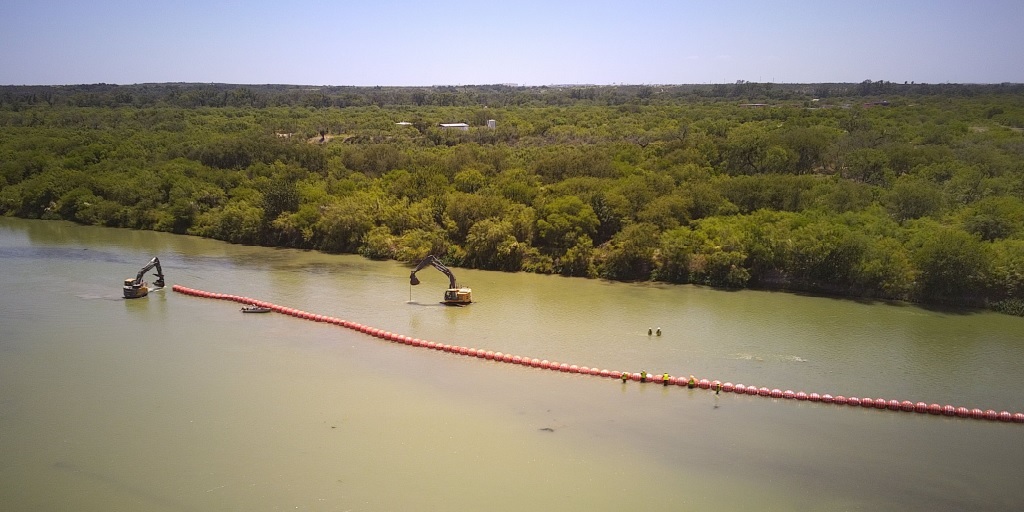Since President Biden took office, Texas Governor Greg Abbott has been escalating both rhetoric and action in response to a rise in migration across the Rio Grande. Right now, challenges to his latest maneuver—installing 1,000 feet of “marine barrier” in the middle of the Rio Grande—are making their way through the courts. As of September 12, the barrier will remain in place while the 5th Circuit hears an appeal from Texas.
Abbott’s anti-immigrant crusade began in 2021 when he started “Operation Lone Star” and ordered Texas state troopers to arrest thousands of migrants on misdemeanor trespassing charges. When migrants began crossing the border in Del Rio, Texas, he ordered state National Guard troops to deploy shipping containers as walls and string razor wire along the riverbanks. Then in July 2023, he installed his marine barrier, made up of a string of 4-foot buoys anchored to the riverbed with heavy concrete blocks. Days later, the Department of Justice sued, and on September 6, a federal judge ordered Abbott to take down the barriers, finding that they violated the federal Rivers and Harbors Act.
One day later, in response to an emergency appeal from Texas, the 5th Circuit Court of Appeals stepped in and issued a temporary administrative stay. That stay was extended indefinitely on Tuesday night, as the 5th Circuit agreed to hear Texas’ appeal on an expedited basis. The decision is a blow to those who have seen the barrier as an escalation in inhumanity from an administration which has fought the Biden administration on migration since day one.
The use of a “buoy barrier” in the Rio Grande was first considered by the Trump administration in 2020, but reportedly rejected because of fears that it “was expected to increase drownings and risks to U.S. agents conducting water rescues.” The buoys became a symbol of Abbott’s escalation at the border in July, when a National Guard whistleblower alleged that children were left without water and forced to crawl through razor wire in order to seek asylum.
Despite the attention paid to the razor wire, the Department of Justice’s lawsuit focused only on the installation of the buoys in the Rio Grande, alleging that Texas was required to obtain a permit before installing any structure in a “navigable” river such as the Rio Grande. In response, Texas argued that the federal Rivers and Harbors Act did not apply because the barrier was only temporary and not permanent, and that the Rio Grande was not “navigable” because the flow of water was too low thanks to dams built on the river.
Texas also argued that, even if the federal law did apply, it was allowed to ignore federal law and install the buoys anyway because it was being “invaded” and could defend itself by any means. This argument was carried to its logical extremes by an anti-immigrant legal advocacy group, the Immigration Reform Law Institute, which argued that the installation of the buoys was Texas’ “chosen means of waging war” in response to an “invasion” of migrants and crime.
These arguments were squarely rejected when judge David Ezra, a Reagan appointee, ruled in favor of the Department of Justice. He rejected Texas’ claim that the buoys were not the kind of structure regulated by federal law, noting that the buoys were anchored to the riverbed by heavy metal chains connected to over 100 tons of concrete and with two feet of stainless steel mesh extending below the water.
As for Texas’s claim that it was allowed to ignore federal law whenever it declares itself “invaded,” Judge Ezra wrote that this was a “breathtaking” argument that would “would give the Governor of Texas more power than is possessed by the President of the Unites States without authorization from Congress.” He also noted that multiple federal courts had already held that questions of “invasion” under the Constitution are political questions not for the federal judiciary to decide, and rules that Texas could not invoke an unprecedented “right to self-defense” to avoid the consequences of violating federal law.
With the Fifth Circuit having stepped in to halt the decision from going into effect, Abbott’s buoys remain in the Rio Grande for now. Since being installed, two bodies have already been found tangled in the steel mesh installed beneath the buoys, including the body of a child. And while the impact of the buoys on migration is reportedly minimal, as many migrants can simply walk around them, they remain as a symbol of the increasingly militarized and harsh border that migrants face when coming to this country.
FILED UNDER: Texas, U.S.-Mexico Border


